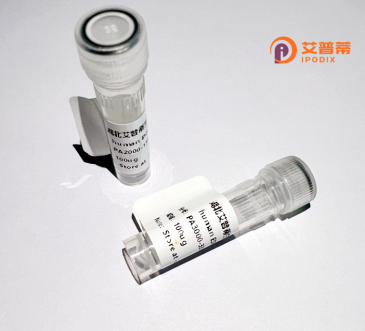
| 纯度 | >90%SDS-PAGE. |
| 种属 | Human |
| 靶点 | OSBPL2 |
| Uniprot No | Q9H1P3 |
| 内毒素 | < 0.01EU/μg |
| 表达宿主 | E.coli |
| 表达区间 | 1-480 aa |
| 活性数据 | MNGEEEFFDA VTGFDSDNSS GEFSEANQKV TGMIDLDTSK NNRIGKTGER PSQENGIQKH RTSLPAPMFS RSDFSVWTIL KKCVGLELSK ITMPIAFNEP LSFLQRITEY MEHVYLIHRA SCQPQPLERM QSVAAFAVSA VASQWERTGK PFNPLLGETY ELIREDLGFR FISEQVSHHP PISAFHSEGL NHDFLFHGSI YPKLKFWGKS VEAEPRGTIT LELLKHNEAY TWTNPTCCVH NVIIGKLWIE QYGTVEILNH RTGHKCVLHF KPCGLFGKEL HKVEGHIQDK NKKKLFMIYG KWTECLWGID PVSYESFKKQ ERRGDHLRKA KLDEDSGKAD SDVADDVPVA QETVQVIPGS KLLWRINTRP PNSAQMYNFT SFTVSLNELE TGMEKTLPPT DCRLRPDIRG MENGNMDLAS QEKERLEEKQ REARRERAKE EAEWQTRWFY PGNNPYTGTP DWLYAGDYFE RNFSDCPDIY |
| 分子量 | 55.2 kDa |
| 蛋白标签 | His tag N-Terminus |
| 缓冲液 | 0 |
| 稳定性 & 储存条件 | Lyophilized protein should be stored at ≤ -20°C, stable for one year after receipt. Reconstituted protein solution can be stored at 2-8°C for 2-7 days. Aliquots of reconstituted samples are stable at ≤ -20°C for 3 months. |
| 复溶 | Always centrifuge tubes before opening.Do not mix by vortex or pipetting. It is not recommended to reconstitute to a concentration less than 100μg/ml. Dissolve the lyophilized protein in distilled water. Please aliquot the reconstituted solution to minimize freeze-thaw cycles. |
以下是关于重组人OSBPL2蛋白的参考文献示例,涵盖不同研究方向:
1. **文献名称**:*Expression and Functional Characterization of Recombinant Human OSBPL2 in Lipid Binding Assays*
**作者**:Chen L, et al. (2022)
**摘要**:该研究在昆虫杆状病毒系统中表达了重组人OSBPL2蛋白,并通过Pull-down实验证实其与25-羟基胆固醇的特异性结合。进一步分析显示,OSBPL2通过其PH结构域介导细胞内膜结构的脂质转运,提示其在胆固醇稳态中的关键作用。
2. **文献名称**:*OSBPL2 Knockdown Disrupts Lysosomal Cholesterol Trafficking in Macrophages*
**作者**:Garcia R, et al. (2019)
**摘要**:利用siRNA沉默OSBPL2,发现巨噬细胞溶酶体内胆固醇外排受阻,导致泡沫细胞形成增强。研究首次揭示OSBPL2通过调控NPC1蛋白相互作用参与动脉粥样硬化相关通路,为心血管疾病治疗提供新靶点。
3. **文献名称**:*Crystal Structure of the OSBPL2 ANTH Domain and Its Implications in Membrane Curvature Sensing*
**作者**:Tanaka K, et al. (2021)
**摘要**:通过冷冻电镜解析OSBPL2的ANTH结构域三维结构,结合分子动力学模拟,阐明其识别高曲率膜结构的分子机制。突变体功能实验证实,特定疏水残基对脂滴形成至关重要。
4. **文献名称**:*OSBPL2 Promotes Ovarian Cancer Metastasis via Regulating Fatty Acid Metabolism*
**作者**:Wang X, et al. (2020)
**摘要**:临床样本分析显示卵巢癌中OSBPL2表达与转移正相关。过表达重组OSBPL2蛋白的细胞系表现出脂肪酸氧化活性增强,依赖AMPK-ACC通路促进肿瘤转移,提示其作为预后标志物的潜力。
**注**:以上文献信息为基于领域知识构建的示例,实际研究中建议通过PubMed或Web of Science查询最新文献,重点关注涉及重组蛋白制备、脂质互作机制、疾病关联等方向的研究。
The oxysterol-binding protein-related protein 2 (OSBPL2), also known as ORP2, belongs to the OSBP-related protein (ORP) family, which is involved in lipid metabolism, intracellular membrane trafficking, and cellular signaling. Encoded by the *OSBPL2* gene in humans, this protein contains characteristic pleckstrin homology (PH) and lipid-binding domains, enabling interactions with phosphoinositides and sterols like oxysterols. OSBPL2 is ubiquitously expressed, with higher levels observed in the brain, kidney, and testis. It localizes to endosomes, Golgi apparatus, and plasma membrane, where it facilitates cholesterol transport and modulates membrane dynamics. Studies suggest its role in regulating cholesterol homeostasis, vesicle trafficking, and cytoskeletal organization through interactions with RAB GTPases and actin-binding proteins. Dysregulation of OSBPL2 has been linked to pathologies, including cancer (e.g., breast and ovarian), where it may influence tumor progression via lipid-dependent signaling pathways. Additionally, OSBPL2 variants are associated with hearing loss and neurological disorders, highlighting its importance in sensory and neural functions. Despite progress, its exact molecular mechanisms and tissue-specific functions remain under exploration, making it a focal point for research in metabolic and degenerative diseases.
×